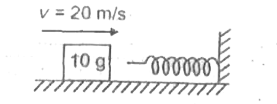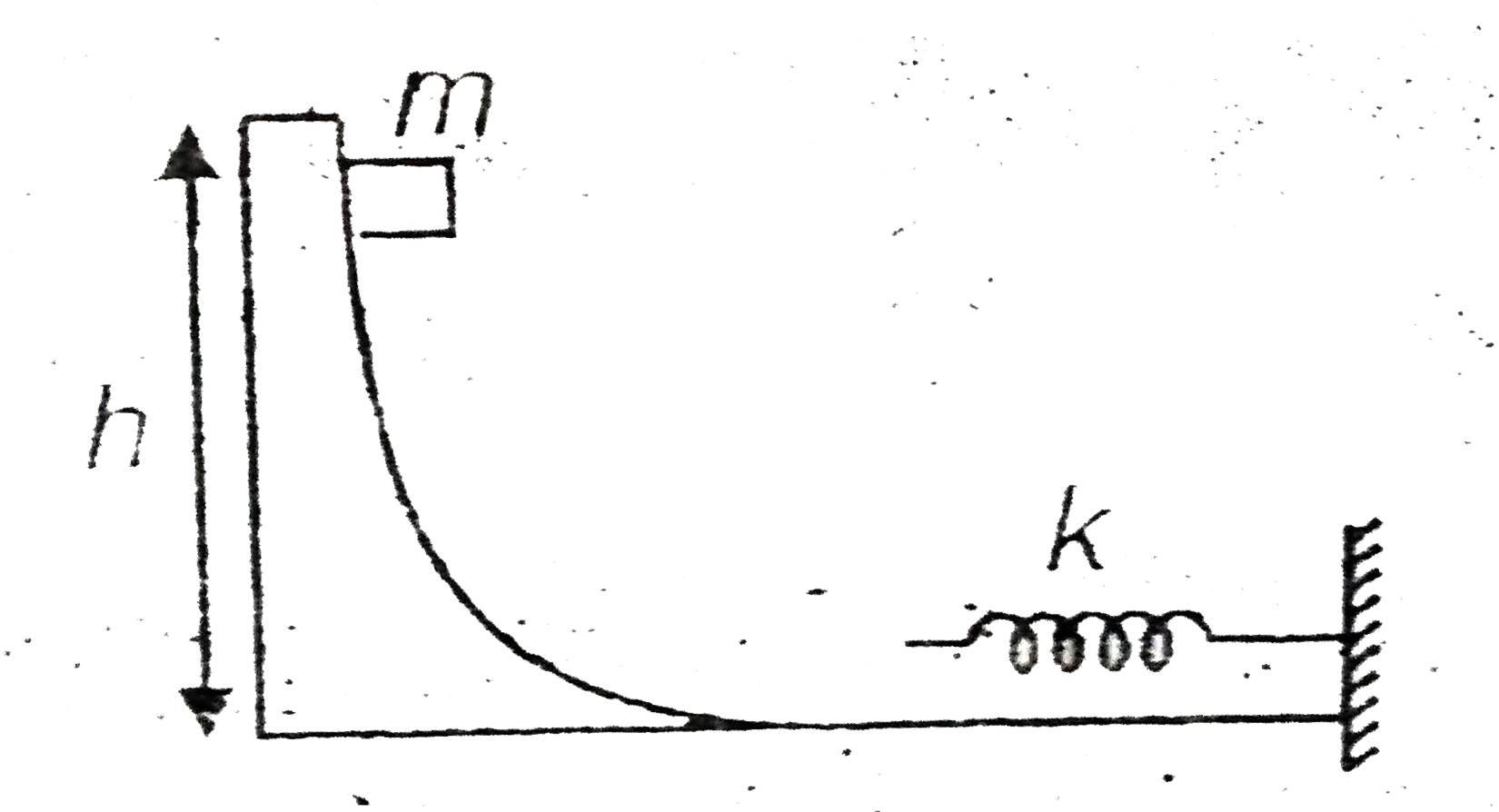A car of mass 1000 kg moving with a speed 18kmh−1 on a smooth road and colliding with a horizontally mounted spring of spring constant 6.25×103Nm−1. The maximum compression of the spring is
1 m
2 m
3 m
4 m
The correct Answer is:B
To solve the problem of finding the maximum compression of the spring when a car collides with it, we can follow these steps:
Step 1: Convert the speed from km/h to m/s
The speed of the car is given as 18 km/h. We need to convert this to meters per second (m/s).
Speed in m/s=Speed in km/h×518
Substituting the value:
Speed in m/s=18×518=5m/s
Step 2: Write down the equations for kinetic energy and potential energy
At maximum compression of the spring, the kinetic energy of the car will be equal to the potential energy stored in the spring.
- Kinetic Energy (KE) of the car:
KE=12mv2
- Potential Energy (PE) of the spring:
PE=12kx2m
Where:
- m=1000kg (mass of the car)
- v=5m/s (speed of the car)
- k=6.25×103N/m (spring constant)
- xm = maximum compression of the spring
Step 3: Set the kinetic energy equal to the potential energy
At maximum compression, we have:
12mv2=12kx2m
Step 4: Simplify the equation
We can cancel 12 from both sides:
mv2=kx2m
Step 5: Solve for maximum compression xm
Rearranging the equation gives:
x2m=mv2k
Taking the square root:
xm=√mv2k
Step 6: Substitute the known values
Now, substituting the values of m, v, and k:
xm=√1000×(5)26.25×103
Calculating the values:
xm=√1000×256250=√250006250=√4=2m
Conclusion
The maximum compression of the spring is 2m.
---
The speed of the car is given as 18 km/h. We need to convert this to meters per second (m/s).
At maximum compression of the spring, the kinetic energy of the car will be equal to the potential energy stored in the spring.
KE=12mv2
PE=12kx2m
- m=1000kg (mass of the car)
- v=5m/s (speed of the car)
- k=6.25×103N/m (spring constant)
- xm = maximum compression of the spring
At maximum compression, we have:
We can cancel 12 from both sides:
Rearranging the equation gives:
Now, substituting the values of m, v, and k:
The maximum compression of the spring is 2m.
Topper's Solved these Questions
- BOOK - NCERT FINGERTPS ENGLISHCHAPTER - WORK , ENERGY AND POWEREXERCISE - NCERT18videos
WORK , ENERGY AND POWER
- BOOK - NCERT FINGERTPS ENGLISHCHAPTER - WORK , ENERGY AND POWEREXERCISE - ASSERTION & REASON15videos
WORK , ENERGY AND POWER
- BOOK - NCERT FINGERTPS ENGLISHCHAPTER - WAVESEXERCISE - Assertion And Reason15videos
WAVES
Similar Questions
Auto manufactures study the collision of cars with mounted spring of different spring constant. Consider a car of mass 1500 kg moving with a speed of 36kmh−1 on a smooth road and colliding with a horizontally mounted spring of spring constant 7.5×103Nm−1. Find the maximum compression of the spring .
View SolutionAuto manufactures study the collision of cars with mounted spring of different spring constant. Consider a car of mass 1500 kg moving with a speed of 36kmh−1 on a smooth road and colliding with a horizontally mounted spring of spring constant 7.5×103Nm−1. Find the maximum compression of the spring .
View SolutionTo stimulat car accidents, the auto manufacturers study the collisions of moving cars with mounted springs of different spring constants. Consider a typical simulation with a car of mass 1000kg moving with a speed of 18.0km/h on a smooth road and colliding with a horizontally mounted spring of spring constant 6.25×103Nm−1. What is the maximum compression of the spring?
View SolutionA body of mass 5 kg moving with a speed of 1.5 m/s on a horizontal smooth surface collides with a nearly weightless spring of force constant k = 5 N/m. The maximum compression of the spring would be
 View Solution
View SolutionA mass of 0.5kg moving with a speed of 1.5m/s on a horizontal smooth surface, collides with a nearly weightless spring of force constant k=50N/m The maximum compression of the spring would be.
View SolutionA solid cylinder of mass 3kg is rolling on a horizontal surface with velocity 4ms−1. It collides with a horizontal spring of force constant 200Nm−1. The maximum compression produced in the spring will be :
View SolutionA block of mass m moving with velocity v0 on a smooth horizontal surface hits the spring of constant k as shown. The maximum compression in spring is
 View Solution
View SolutionEach of the blocks shown in figure has mass 1 kg. The rear block moves with a speed of 2 m/s towards the front block kept at rest. The spring attached to the front block islight and has a spring constant 50 N/m. find the maximum compression of the spring.
 View Solution
View SolutionA block of 10 g slides on smooth horizontal surface with 20 m/s towards a spring of spring constant 100 N/m placed horizontally (as shown in figure). The maximum compression in spring is
 View Solution
View SolutionA block of mass m is released from a height h from the top of a smooth surface. There is an ideal spring of spring constant k at the bottom of the track. Find the maximum compression in the spring (Wedge is fixed)
 View Solution
View Solution

